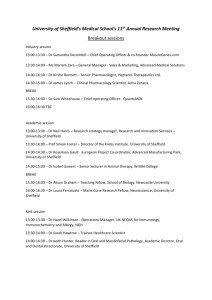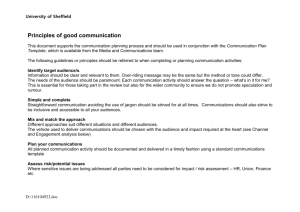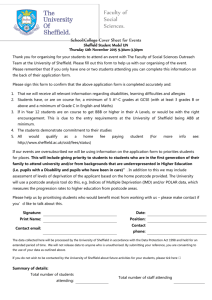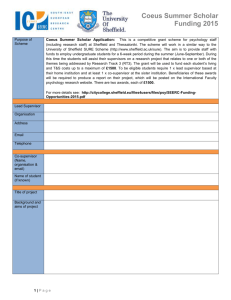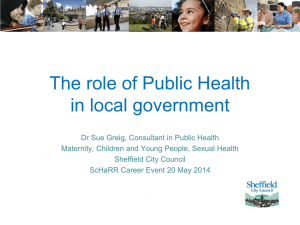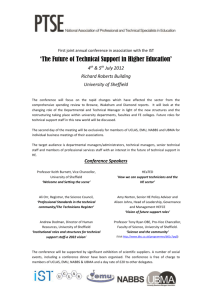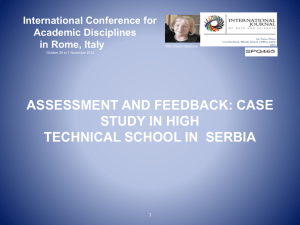Check SYCC collection - Sheffield City Council
advertisement
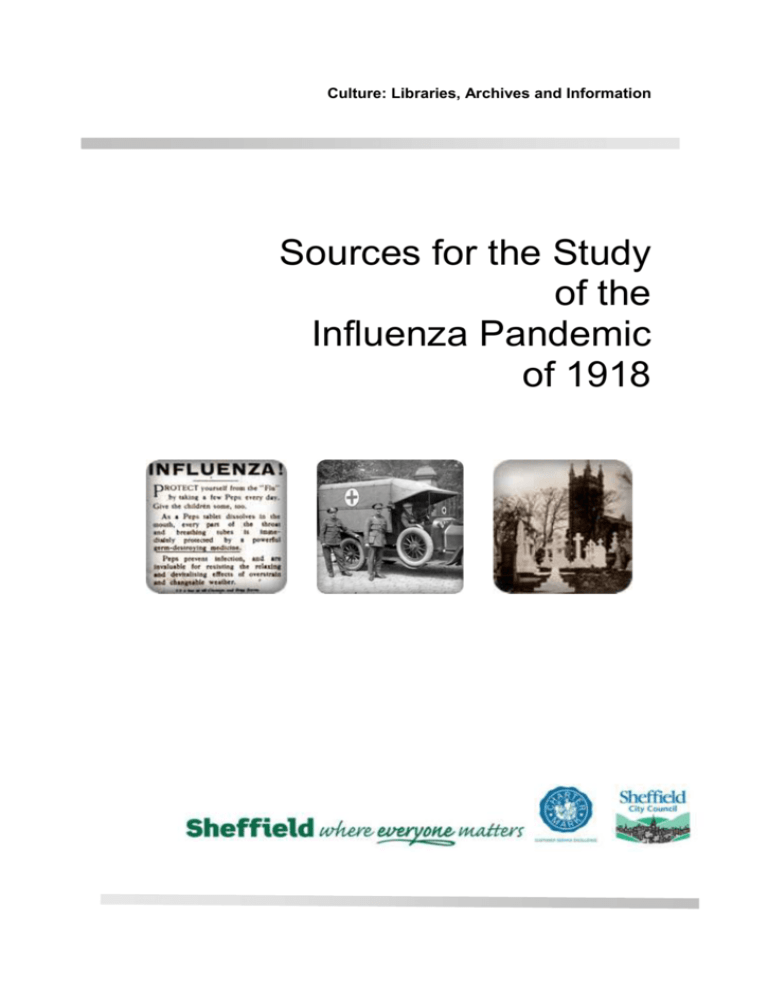
Culture: Libraries, Archives and Information Sources for the Study of the Influenza Pandemic of 1918 © Sheffield Libraries Archives and Information 2009 Front Cover Illustrations – left to right Advertisement for Peps Pills (Sheffield Local Studies Library: Sheffield Independent, 31 October 1918) Ambulance, c. 1918 (Sheffield Local Studies Library: Picture Sheffield y00090) Cemetery (Sheffield Local Studies Library: Picture Sheffield s04531) Images can be copied for private or educational use without permission from us, though we ask that the following acknowledgement is included ‘[document reference number] From the collections of Sheffield Libraries Archives and Information’. Please contact us if you wish to publish, exhibit or broadcast any of the information within this Guide. Contents Introduction 4 Timeline of selected key events 5 Selection of images from the Sheffield Local Studies Library and Sheffield Archives collections: Statistics 6 The impact 7 Impact on individuals 8 Impact on schools 9 Impact on social life 10 Advertisements for cures 11 List of documents, books, photographs and other items available at Sheffield Libraries, Archives and Information 12 - 15 Library and archive collections held elsewhere 15 - 16 Sheffield Local Studies Library and Sheffield Archives facilities 17 Adding to our collections 17 Contact details 18 © Sheffield City Council, 2009 Page 3 of 18 Introduction This booklet lists sources available within Sheffield Libraries Archives and Information for the study of the influenza pandemic of 1918. It is not a detailed history; it merely points the reader who wishes to carry out their own research to what is available within Sheffield Libraries and Archives. More people died of ‘flu between 1918 and 1920 than had been killed in World War One, yet this episode in history lies largely untold. There appear to be few local studies of the health crisis which led to many deaths, the overwhelming of the emergency and health services, the closing of schools and restrictions on the movement of people. The main outbreaks coincide with the end of World War One, which perhaps partly explains why the ‘flu crisis is often overlooked. Yet at its height over 300 Sheffielders were dying a week. Not only were hospitals unable to cope, but with a shortage of both labour and coffins, mortuaries and undertakers were overwhelmed. A check of the main catalogues and indexes at Archives and Local Studies will only reveal a tiny fraction of what is available. This is because references to the pandemic are often hidden deep within records whose main emphasis lies elsewhere. This Guide begins the process of opening up the records to a wider audience. As more items are catalogued and the collections are used by researchers it is likely that additional influenza references will come to light. © Sheffield City Council, 2009 Page 4 of 18 Timeline of selected key dates 1918 - 1920 19 Jul 1918 Beighton School head teacher reports ‘influenza is still raging’ Oct - Nov 1918 1,332 deaths from influenza in Sheffield 18 Oct 1918 Attendance at All Saints School, Pitsmoor ‘seriously affected’ 30 Oct 1918 City Hospitals and Health committees hold joint meeting to discuss the crisis 31 Oct 1918 Appeal for more medical staff published in local newspapers 5 Nov 1918 Reports of ‘Tram Service Crippled’ Nov - Dec 1918 450 deaths from influenza in Sheffield 9 Nov 1918 Burials take place late at night to keep pace 28 Nov 1918 Places of entertainment restrictions in place 22 May 1919 Places of entertainment restrictions end May 1920 225 deaths from influenza in Sheffield May 1920 Five additional wards at Lodge Moor Hospital opened May 1920 Sheffield Medical Officer of Health issues advice leaflet May 1920 New appeal for medical staff to come forward Aug - Sep 1920 1 death from influenza in Sheffield © Sheffield City Council, 2009 Page 5 of 18 Statistics There are three main sources of figures for infections and deaths from influenza. The first are the detailed statistical and written reports compiled every four weeks by the Sheffield Medical Officers of Health, Dr Scurfield and later, Dr Wynne. These are included in the minutes of the City Council’s Health Committee and they show the number of deaths from a variety of illnesses such as typhoid, scarlet fever, measles etc in addition to influenza. Death rates are compared amongst towns and cities across the country. Medical Officer of Health statistical table in Health Committee minutes, 1920 (Sheffield Archives CA-MIN/57 and Local Studies Library: 352.042 SQ) From these monthly reports the following graph has been compiled: Influenza deaths 1917-1920 1400 No of deaths 1200 1000 800 600 400 200 D ec 19 16 - Ja n M 1 ar -A 917 pr 1 Ju n- 917 Ju Se l1 D ec p -O 917 ct 19 17 1 9 1 -J an 7 M 1 ar -A 918 pr 19 J u 18 n Au g - 191 S ep 8 N 19 ov 18 -D e Fe c 1 91 bM ar 8 1 M 919 ay 19 Au 19 g O 1 ct -N 919 o Ja v 1 9 nFe 19 b 19 Ap 20 r1 92 Ju 0 Se l p - 192 O ct 0 19 20 0 Date Another source is the annual reports of the Medical Officer of Health. These are available on microfilm at the Local Studies Library and contain statistics and reports of the attempts made by the City’s Health Department to deal with the problem. Local newspapers also provide details on the spread of the virus and the numbers affected. The reports also provide details of coroner’s inquests on some of the victims, especially useful as the original inquest files do not survive. © Sheffield City Council, 2009 Page 6 of 18 The Impact All walks of life were affected by the crisis - hospitals were overwhelmed, extra staff were called in and additional wards opened, conscription for medical staff was temporarily suspended, schools closed, cinemas had to disinfect their premises, there were not enough staff to bury the dead, shortages of coffins were reported and supplies of ‘remedies’ such as Bovril sold out. Amongst the archive collections there may be references in hospital records, business archives and records from a wide variety of institutions that cover the 19181920 period. Here are some examples of evidence of the effect of the virus taken from minutes of meetings and newspaper reports. 200 waiting to be buried at Burngreave Cemetery 70 coffins on order, funerals delayed 25 bodies waiting removal, bodies left for some days 37 inmates of the workhouse dead Nurses, cook, porters, chauffer infected, some of the staff have died All the hospitals of the City are full. A doctor and nurse have died, 30 nurses and ward maids are down Work is too heavy for horse drawn ambulances Tram passengers urged to ‘make the best of things’ during the tram shortage © Sheffield City Council, 2009 Page 7 of 18 Death rate ‘appalling’ The Impact on Individuals There is no list or index of ‘flu victims. Most of the surviving records relate to how the authorities dealt with the crisis. The main source of information on individuals will be hospital admission and discharge registers. See pages 14 - 15 for details of these. The Registrar of births, marriages and deaths keeps death certificates which record the name, address and age of the deceased along with cause of death and other information. You can access the index to death certificates via Ancestry.com which is available for free at every Sheffield Library and in the Archives searchroom. To purchase a copy of a death certificate you need to contact the Register Office. Above - extract from a hospital admission register. Left - Fulwood churchyard. Below - reports on inquests. The newspapers carried reports of difficulties in burying the dead quick enough. At the city cemeteries there were reports of funerals taking place in the (dark) evenings to reduce the backlog of bodies. Sheffield Archives has registers of burials in the civil cemeteries as well as in parish churchyards. These don’t record the cause of death but they will reveal a surge in entries at the peaks of the epidemic. The registers, along with Monumental Inscriptions (indexes and some transcripts of information of headstones) will also reveal the human side of the crisis. In many cases the gravestones may still be available to see in the cemetery. There are no inquest or post mortem files from the coroner from this period, however occasionally details will be reported in the newspapers. © Sheffield City Council, 2009 Page 8 of 18 The Impact on Schools School logbooks can be used to gather evidence of the epidemic. Log books were official diaries kept by the head teacher recording events in the school. Sickness and absence figures for influenza feature in the log books from Sheffield schools. There are over 90 school log books available for the period 1918-1920, representing all parts of the city. Here are some extracts from Beighton Council School log book (Sheffield Archives ref. CA35/20) for 1918 as an example. Note the entry for Armistice Day. Beighton Council School (Picture Sheffield s06152) 19 July 1918 Influenza is still raging, many new cases. 10-11 Jul 1918 a serious epidemic of influenza has developed rapidly this week. 49 children being absent the whole week. The attendance gradually dwindling until there were 142 children absent Friday afternoon. 25 October 1918 School closed until Nov 4th by order of Dr Peck, Medical Officer of Health to prevent the spread of influenza. 4 November 1918 The Medical Officer of Health has ordered the school to be closed for a further period until 11 November. 16 November 1918 Clerk telephoned that Dr Peck had ordered the closure for still another week. © Sheffield City Council, 2009 11 November 1918 School re-opened this morning - Mrs Hollies, Mrs Robinson and Miss Tyson and 150 children absent. Telephoned the clerk. Dr Peck ordered the closure for another week. 25 November 1918 School reopened, the whole staff being present. Owing to the closing of the school for 4 weeks it is not possible to complete the terms examination. Page 9 of 18 The Impact on Social Life Large gatherings of people were obviously a risk in spreading the virus. The authorities took steps to address this. Some schools closed, people were advised to avoid large crowds, and restrictions were placed on entertainment venues such as cinemas. Cinema showings were restricted in length and premises had to be ventilated. In some parts of the country they were ordered to rip out their carpets. The Picture Palace cinema on Ecclesall Road requested an exemption from the regulations - it was refused by the Health Committee. Local newspapers include advertisements for cinema with reassurances that the owners had taken precautions to reduce the risk of infection. This theatre is fitted with Haden’s ventilation, the air being changed twelve times per hour and is drawn through screens saturated with disinfectant © Sheffield City Council, 2009 Page 10 of 18 Advertisements for Cures With growing public concern over the epidemic manufacturers of medicinal products took advantage and advertised their wares on the basis that they prevented infection. The Government provided advice on how to reduce the risks, including ‘healthy and regular habits’, ‘avoidance of alcoholic excess’ and ‘gargling with a tumbler of warm water … and permanganate of potash’. Remedies appear to have been popular - the Bovril advert tells of a shortage of bottles and advise those who already have some at home to resist buying more. © Sheffield City Council, 2009 Page 11 of 18 List of documents, books, photographs and other items for further research Honigsbaum, Mark Living with Enza : the forgotten story of Britain and the great flu pandemic of 1918 (Macmillan, 2009) (Sheffield Central Lending Library: 614.518) Quinn, Tom Flu : a social history of influenza (New Holland, 2008) (Sheffield Central Lending Library: 614.518) Kolata, Gina Flu; the story of the great influenza pandemic of 1918 and the search for the virus that caused it (Pan Books, 2000) (Sheffield Central Reference Library: 614.518) Beveridge, William Ian Beardmore Influenza : the Last Great Plague : an Unfinished Story of Discovery (Heinemann, 1977) (Sheffield Central Reference Library: 616.203) Relevant articles and features may appear in local newspapers. The main titles available at Sheffield Local Studies Library for this period include: Sheffield Daily Telegraph, Sheffield Independent and the Star. Archives of some national newspapers are available on the internet, notably The Times (http://archive.timesonline.co.uk) and The Guardian (http://archive.guardian.co.uk) Sheffield City Council, Council minutes, 1917 – 1920 Note: these include reports from the Medical Officer of Health in the Health Committee minutes (Sheffield Archives: CA-MIN and Sheffield Local Studies Library: 352.042 SQ) Sheffield City Council, Health Committee minutes and reports, 1917 – 1920 (Sheffield Archives: CA-HEA) Sheffield City Council: Sanitary sub-committee minutes, 1917 - 1920 (Sheffield Archives: CA39) Sheffield City Council, Hospitals Committees minutes and reports, 1917 – 1920 (Sheffield Archives: CA113) Sheffield City Council, Education Committee and its sub-committees (such as School Medical Committee), 1917 – 1920 (Sheffield Archives: CA-EDU) Other local authorities administered areas that in 1918 were outside the city boundary. Sheffield Archive has minutes of some of these urban and rural district councils which may include references to the epidemic. The following is a list of such council’s with minutes covering the 1917-1920 period: Cudworth Urban District Council (Sheffield Archives: SY2) © Sheffield City Council, 2009 Page 12 of 18 Darfield Urban District Council (Sheffield Archives: SY4) Dodworth Urban District Council (Sheffield Archives: SY1) Handsworth Urban District Council (Sheffield Archives: CA46) Hemsworth Rural District Council (Sheffield Archives: SY9) Norton Rural District Council (Sheffield Archives: CA51) Penistone Rural District Council (Sheffield Archives: SY3) Stocksbridge Urban District Council (Sheffield Archives: CA60) Wombwell Rural District Council (Sheffield Archives: SY8) Worsbrough Urban District Council (Sheffield Archives: LD1528-1530) Sheffield City Council, Medical Officer of Health annual reports, 1917 – 1921 (Sheffield Local Studies Library: 352.4 SQ microfilm) Sheffield City Council, School Medical Officer of Health annual reports, 1917 – 1921 (Sheffield Archives: X55 and Sheffield Local Studies Library: 371.712 S) Stocksbridge Urban District Council: monthly reports of the Medical Officer of Health, 1917 - 1920 (Sheffield Archives: CA76) Sheffield Insurance Committee and Medical benefit Sub-Committee minutes, 1917 – 1920 These include reference to the increased number of ‘scripts’ [?prescriptions] during the epidemic. (Sheffield Archives: CA34) Sheffield Board of Guardians minutes, 1917 – 1920 These include references to staff and inmates at the Fir Vale Institution (workhouse) being sick. (Sheffield Archives: CA692 and Sheffield Local Studies Library: 352.9 SQ) Wortley Board of Guardians minutes, 1917 - 1920 (Sheffield Archives: SY164) Businesses were affected by high absenteeism. There may be references in board of director’s and other committee minutes. Sheffield Archives has a large collection of business records (for instance the Firth Brown steel company, ref. FBA). Tinsley Nursing Association, minutes and accounts, 1918 - 1920 (Sheffield Archives: SY401) Barnsley and Sheffield Sanatorium and Medical Benefits sub-committee minutes, 1917 - 1920 (Sheffield Archives: CA34) Oral history Collection - Mr Jackson speaks of the 1918 ‘flu pandemic (Sheffield Local Studies Library: Tape No. St Mary’s 48) © Sheffield City Council, 2009 Page 13 of 18 Cemetery registers Sheffield Archives has a comprehensive collection of cemetery burial registers. These will document the peaks in burials during the epidemic. The main cemeteries at this period were at City Road, Burngreave, Attercliffe, Darnall and Tinsley Park. A full list is available on our website www.sheffield.gov.uk/archives (click on ‘what collections do we have?’ and then ‘cemetery registers’). Churchyard burial registers In addition to civil cemeteries there were church burial grounds. A full list of Anglican church burial registers is available on our website www.sheffield.gov.uk/archives (click on ‘what collections do we have?’ and then ‘parish registers’). Death Certificates The Register office (Town Hall, Pinstone Street, Sheffield, S1 2HH, www.sheffield.gov.uk/your-city-council/register-office) has death certificates from 1837 onwards. These record the name, age, address, cause of death and other information. Monumental Inscriptions Sheffield Archives has a comprehensive collection of Monumental Inscriptions (details taken from headstones in cemeteries). A full list is available on our website www.sheffield.gov.uk/archives (click on ‘what collections do we have?’ and then ‘monumental inscriptions’). School log books Sheffield Archives has a comprehensive collection of school log books (head teachers diaries), almost 100 of which cover the 1918 - 1920 period. A full list is available on our website www.sheffield.gov.uk/archives (click on ‘what collections do we have?’ and then ‘schools’). Photographs Over 35,000 images from the Sheffield Local Studies Library photographic collection are available to search online at www.picturesheffield.com. Hospital records Minutes of board’s of governors, house and other committees may record how the hospital was affected by ‘flu. In some cases registers of admission and discharge record the illness the patient was suffering from. Note that patient records are confidential for 100 years. Please contact Sheffield Archives for advice on how to access these. The list below includes hospitals with relevant records dating from the 1916-1920 period. Sheffield Children's Hospital - Honorary/Medical Staff Committee minutes (Sheffield Archives: NHS8) Sheffield Union Hospital (Fir Vale Hospital, formerly the workhouse) administrative records (Sheffield Archives: NHS2) © Sheffield City Council, 2009 Page 14 of 18 King Edward VII Orthopaedic Hospital, Sheffield - staff registers (Sheffield Archives: NHS11) Jessop Hospital for Women, Sheffield - Board of Governors and committee minutes, reports, staff records (Sheffield Archives: NHS12) Lodge Moor Hospital, Sheffield - staff vaccination register, admission registers (Sheffield Archives: NHS9) Lodge Moor Hospital: Military Sick - admission and discharge books, papers (Sheffield Archives: NHS37) Middlewood Hospital, Sheffield - committee minutes, annual reports, patient admissions, case files, discharges and deaths (Sheffield Archives: NHS3) Nether Edge Hospital, Sheffield (formerly Ecclesall Bierlow Workhouse) patient records (Sheffield Archives: NHS21) Royal Hospital, Sheffield - Governors meeting minutes, annual reports, staff books (Sheffield Archives: NHS16) Royal Infirmary, Sheffield - administrative records (Sheffield Archives: NHS17) Sheffield Hospital Sunday Fund - minutes and administrative papers (Sheffield Archives: NHS28) Winter Street Military Hospital [3rd Northern General Hospital], Sheffield admission and discharge books: papers (Sheffield Archives: NHS37) Beckett Hospital, Barnsley - committee minutes and papers (Sheffield Archives: NHS1) Kendray Fever Hospital, Barnsley - admission registers (from 1920) (Sheffield Archives: NHS6) © Sheffield City Council, 2009 Page 15 of 18 Library and Archive collections held elsewhere Online newspaper archives are a good source for national press articles. See The Times (http://archives.timesonline.co.uk) and The Guardian (http://archive.guardian.co.uk). Extracts from the British Medical Journal from 1840 are available online at: http://www.bmj.com/archive In 1918 some places now within the Sheffield city boundary were part of other areas (for example, Norton was in Derbyshire, Handsworth was in West Yorkshire). In such cases records may be in the relevant record office and local studies library: Derbyshire Record Office: www.derbyshire.gov.uk/leisure/record_office Derbyshire Local Studies Library: www.derbyshire.gov.uk/leisure/local_studies West Yorkshire Archive Service: www.archives.wyjs.org.uk Barnsley Archives and Local Studies: www.barnsley.gov.uk/archives Doncaster Archives: www.doncaster.gov.uk/Leisure_in_Doncaster/Libraries/Archives_Local _Studies/Doncaster_Archives.asp Doncaster Local Studies: http://www.doncaster.gov.uk/Leisure_in_Doncaster/Libraries/Archives_ Local_Studies/Local_Studies_Library.asp Rotherham Archives and Local Studies: www.rotherham.gov.uk/graphics/Learning/Archives The Access to Archives online database (A2A) contains catalogues describing archives held locally in England and Wales www.nationalarchives.gov.uk/a2a The Archives Hub contains catalogues describing archives held in universities and colleges in the UK www.archiveshub.ac.uk/mar04.shtml The National Archives (TNA) holds records of central government departments and agencies such as the Ministry of Health. You can search the TNA catalogue online at www.nationalarchives.gov.uk. The Wellcome Trust Library includes copies of medical officer of health reports for Sheffield City Council and for urban and rural district councils. The coverage for the 1917 - 1920 period is rather patchy however. You can search the online catalogue at: http://catalogue.wellcome.ac.uk © Sheffield City Council, 2009 Page 16 of 18 Sheffield Archives and Local Studies services collect and preserve original records and printed material relating to Sheffield and the surrounding area. The information dates from the 12th century to the present and relates to Sheffield, South Yorkshire and north Derbyshire. Included are extensive collections of books ● pamphlets ● photographs ● church registers ● newspapers ● census records ● minutes ● diaries ● films ● maps ● deeds ● records from schools ● hospitals ● businesses and charities ● family estates ● personal papers etc. Our facilities include: Study areas ● expert staff on hand to help you make the most of your visit ● a library of reference books ● photocopying and photography services ● free Internet access ● microform machines and printers ● catalogues and indexes ● a range of useful publications for sale ● CD-Rom library ● online image library. Adding to our collections Sheffield Libraries and Archives seeks to preserve information about events in our city’s history. If you have photographs or personal papers that may be worth preserving please consider safeguarding them for current and future generations by placing them in the care of Sheffield Libraries and Archives. It is only through the generosity of individuals and organisations that we are able to have a complete record of important events in the history of Sheffield and the nation. We are interested in photographs, flyers and posters, minutes of meetings etc. For advice on record keeping and the facilities we offer please contact Peter Evans, Archives & Local Studies Manager (pete.evans@sheffield.gov.uk or 0114 203 9397). © Sheffield City Council, 2009 Page 17 of 18 Sheffield Local Studies Library 1st floor Central Library Surrey Street Sheffield S1 1XZ Sheffield Archives 52 Shoreham Street Sheffield S1 4SP Tel: 0114 273 4753 Tel: 0114 203 9395 Fax: 0114 273 5009 Fax: 0114 203 9398 localstudies.library@sheffield.gov.uk archives@sheffield.gov.uk General details: www.sheffield.gov.uk/archives For 35,000 images of Sheffield www.picturesheffield.com Local Studies catalogues (since 1997): http://library.sheffield.gov.uk/uhtbin/webcat (Selected) Archives catalogues: www.nationalarchives.gov.uk/a2a © Sheffield City Council, 2009 Page 18 of 18
